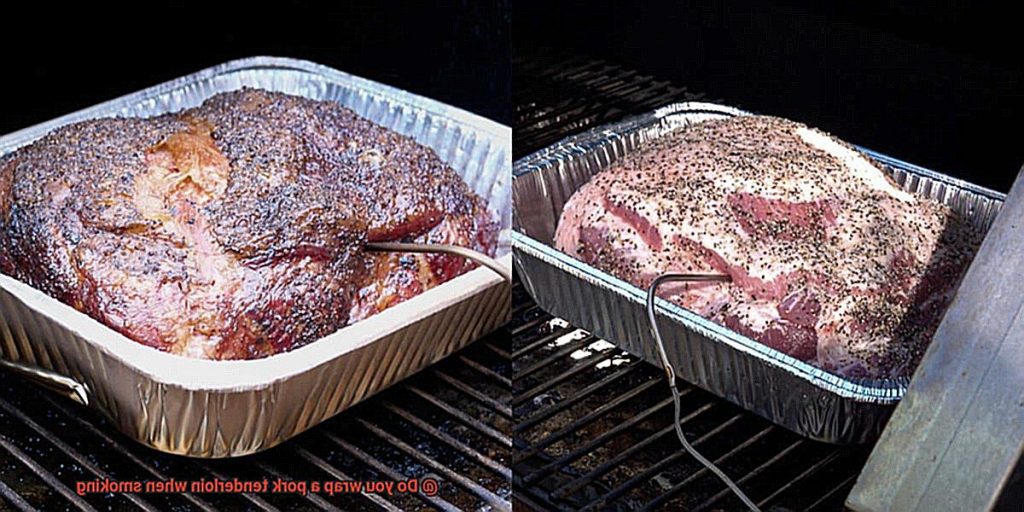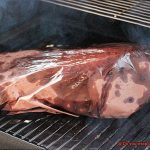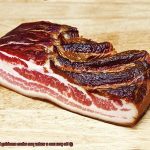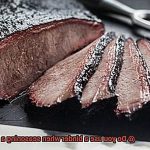Smoking meat is like a slow dance with fire. It’s a delicate balance between heat, smoke, and time that can make or break your dish. When it comes to pork tenderloin, there’s one question that has pitmasters scratching their heads: to wrap or not to wrap?
The debate over whether wrapping pork tenderloin while smoking is a good idea has been raging for years. Some swear by it, saying that it locks in moisture and flavor, while others argue that it can ruin the texture and prevent the meat from developing a delicious bark.
In this blog post, we’re going to explore the ins and outs of wrapping pork tenderloin while smoking. We’ll dive deep into the science behind this technique, examining how it affects the cooking process and ultimately, the taste and texture of your meat.
Whether you’re a seasoned pro or just starting out on your smoking journey, this post will give you all the information you need to make an informed decision about whether or not to wrap your next pork tenderloin. So grab a cold drink and get ready to learn – things are about to get smoky.
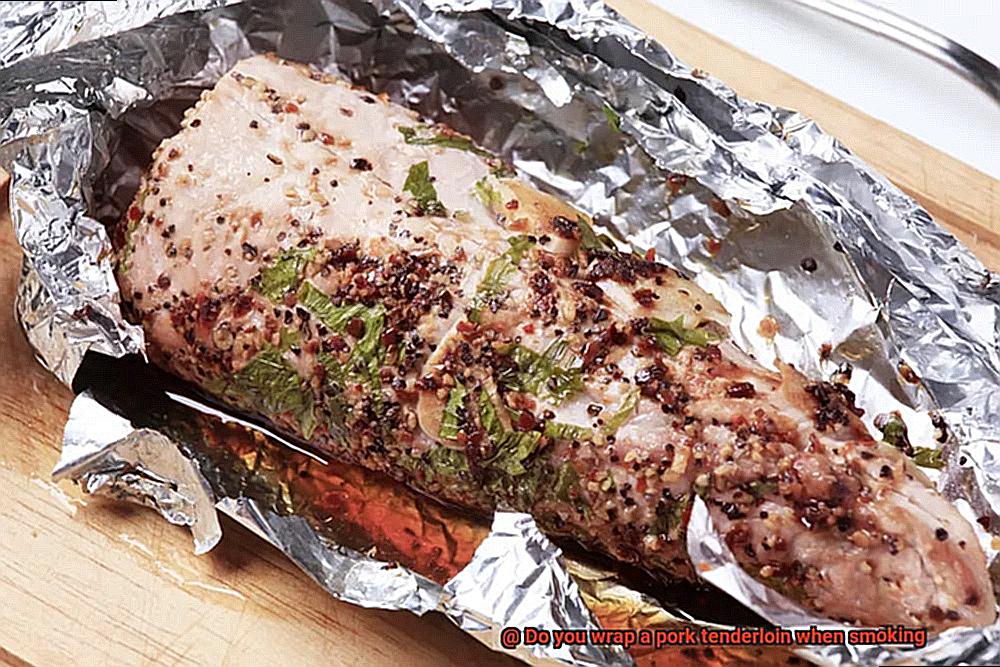
Contents
What is a Pork Tenderloin?
This long, thin piece of meat hails from the muscle that runs along the backbone of a pig. The pork tenderloin is not only one of the most tender cuts of pork, but it’s also one of the leanest, making it a healthier option for meat lovers.
Weighing between 1 and 2 pounds, this cylindrical-shaped meat differs from other pork cuts such as ribs or shoulders. It contains less fat and connective tissue, which means it cooks quickly. However, overcooking can result in dry and tough meat. To avoid this, pitmasters often wrap it in bacon or marinate it to help keep the meat moist.
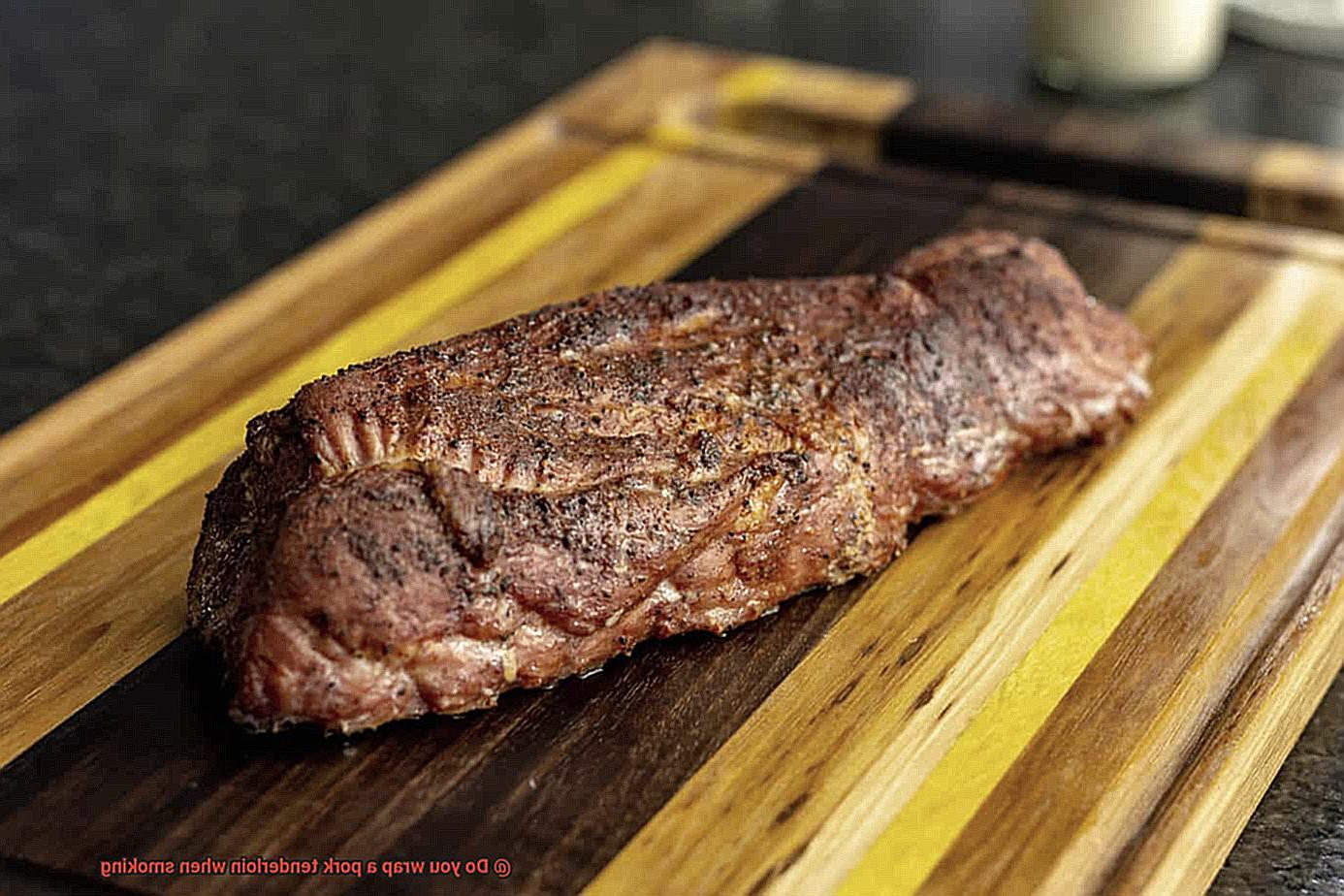
Pork tenderloin is incredibly versatile and can be cooked using various methods such as grilling, roasting, sautéing, and smoking. Each cooking method brings out unique flavors and textures. When smoking pork tenderloin, pitmasters have two options: wrap or not to wrap.
Wrapping a pork tenderloin in foil or butcher paper while smoking helps trap moisture inside, resulting in a juicier and more flavorful meat. However, some pitmasters prefer to skip the wrapping process to achieve a firmer texture and more robust smoke flavor.
Should You Wrap a Pork Tenderloin When Smoking?
Smoking pork tenderloin is an art form, and one of the most debated topics in this realm is whether or not to wrap it. As an expert, I have researched and compiled the pros and cons of wrapping a pork tenderloin when smoking, to help you make an informed decision.
Let’s start with the argument for wrapping. Those who advocate for wrapping the pork tenderloin usually do so with aluminum foil or butcher paper. Wrapping creates a tighter seal around the meat, trapping moisture inside and preventing it from drying out during the smoking process. This results in a moist and tender meat that is sure to impress your guests. Additionally, the added insulation helps the meat cook faster and more evenly, which can be a lifesaver if you’re in a time crunch or feeding a crowd.
However, some pitmasters prefer to leave their pork tenderloin unwrapped. One reason for this is that leaving it unwrapped allows for better smoke penetration. The smoke circulates more freely around the meat, infusing it with flavor and creating a more intense smoky taste. This can take your smoked pork tenderloin to the next level of deliciousness. Additionally, leaving it unwrapped allows for a firmer crust to develop on the outside, which adds texture and flavor to the meat.
Ultimately, whether or not you should wrap your pork tenderloin when smoking comes down to personal preference and experimentation. There is no one “right” way to smoke meat – what works best for one person may not work as well for another. So, why not try both methods? Experiment with wrapping your pork tenderloin for one cook and leaving it unwrapped for another. This will give you an idea of what method produces the best results for your taste preferences and equipment.
Benefits of Wrapping a Pork Tenderloin When Smoking
The good news is that wrapping your pork tenderloin in foil or butcher paper can have some serious benefits.
Firstly, wrapping your pork tenderloin helps to retain moisture. Pork tenderloin is a lean cut of meat that can easily dry out if overcooked. But by creating a seal with the wrap, it traps in moisture and allows the meat to cook in its own juices, resulting in a succulent and juicy piece of pork that will leave you wanting more.
Not only does wrapping help retain moisture, but it also enhances the flavor of the pork. When wrapped, the smoke and flavors from any rubs or seasonings used on the meat are absorbed more fully into the meat, resulting in a more intense and complex flavor profile compared to simply smoking without wrapping.
Additionally, wrapping your pork tenderloin can also reduce cooking time. By creating a seal around the meat, it allows for more even heat distribution and helps to cook the meat faster. This means you can get your meal on the table faster without sacrificing flavor or tenderness.
While there are some who argue against wrapping their pork tenderloin during smoking, claiming it can hinder bark development or texture preferences, it’s ultimately up to personal preference. The benefits of wrapping your pork tenderloin include retaining moisture, enhancing flavor, and reducing cooking time.
Drawbacks of Wrapping a Pork Tenderloin When Smoking
If you’re planning on smoking a succulent pork tenderloin, you may be wondering if wrapping it in foil is the right move. While wrapping your meat can help cook it faster and retain moisture, there are some drawbacks you should consider before making your decision.
First off, let’s talk flavor. Wrapping your pork tenderloin may lead to a lack of that beloved smoky taste that comes with smoking meats. When wrapped, the meat steams in its own juices, diluting the smoky flavor that many people crave in their smoked meats. If you want that pronounced smoky taste, it’s best to leave your pork tenderloin unwrapped.
Another issue with wrapping is that it can result in a less crispy exterior. Who doesn’t love a perfectly caramelized crust on their meat? But when you wrap it up, moisture gets trapped inside and prevents that satisfying texture. So, if you’re all about the crispy exterior (and who isn’t?), it’s best to leave your pork tenderloin unwrapped during the smoking process.
Finally, wrapping your pork tenderloin can make it more challenging to achieve the desired internal temperature. Since the meat steams in its own juices when wrapped, it can be difficult to get an accurate reading with a meat thermometer. This can lead to overcooked or undercooked meat – not ideal when trying to impress dinner guests.
In summary, while wrapping your pork tenderloin when smoking can have some benefits (like retaining moisture and cooking faster), there are also drawbacks to consider. To help you make an informed decision, we’ve compiled a list of sub-topics for you to weigh:
- Benefits of wrapping: faster cooking and moisture retention
- Drawbacks of wrapping: lack of smoky flavor, less crispy exterior and challenging temperature control
- Consider your cooking preferences: if you prioritize smoky flavor and crispy texture over fast cooking time and moisture retention, leave your pork tenderloin unwrapped during smoking.
Tips for Wrapping a Pork Tenderloin When Smoking
Smoking a pork tenderloin is a great way to infuse it with smoky flavor, but wrapping the meat is crucial to achieving the perfect texture and taste. To ensure that your pork tenderloin turns out moist, tender, and flavorful every time, here are some tips for wrapping it when smoking.
Choose the Right Wrap
When wrapping your pork tenderloin, you have two options:
Add Seasoning
Before wrapping your pork tenderloin, apply a rub or marinade to enhance flavor. Be generous with the seasoning as it will infuse into the meat while it smokes. This will add an extra layer of flavor to your dish.
Wrap Tightly
Whether using foil or butcher paper, wrap the pork tenderloin tightly to prevent air from escaping. This will help retain moisture and ensure even cooking. The tighter the wrap, the more deliciously juicy your pork tenderloin will be.
Don’t Overwrap
While it’s important to wrap tightly, make sure not to overwrap the pork tenderloin. Too much foil or paper can prevent smoke and heat from penetrating the meat properly, affecting the taste and texture of your final product.
Use a Thermometer
To ensure that your pork tenderloin is cooked safely and perfectly, use a meat thermometer. Insert it into the thickest part of the meat without touching bone or fat. An internal temperature of at least 145°F is recommended for safe consumption.
Alternatives to Wrapping a Pork Tenderloin When Smoking
Wrapping in foil or butcher paper is a common practice, but it’s not the only way to achieve juicy, flavorful meat. As an expert in this field, let me share with you some exciting alternatives to try.
Firstly, consider using a marinade or brine to infuse the meat with flavor and moisture. Marinades typically consist of a mixture of acid, oil, and seasonings, while brines involve soaking the meat in a salty solution. Both methods are excellent at keeping the pork tenderloin moist and full of flavor without the need for wrapping.
If you’re looking to add more layers of flavor during the smoking process, basting the pork tenderloin with a mop sauce is a fantastic option. Mop sauces are thin, tasty liquids that are brushed onto the meat at regular intervals, helping to keep it moist and adding extra flavor. Popular mop sauce ingredients include apple cider vinegar, Worcestershire sauce, and beer.
For those who love a pronounced smoke flavor and crust on their meat, try smoking your pork tenderloin without any wrapping or basting at all. This method can produce a slightly drier exterior but still results in juicy and flavorful meat.
TLF78qqWJyE” >
Conclusion
In the world of smoking meat, there are few questions as hotly debated as whether or not to wrap a pork tenderloin. Some swear by the technique, claiming that it locks in moisture and elevates flavor. Others argue that wrapping dilutes the smoky taste and prevents a crispy exterior.
Ultimately, the decision to wrap your pork tenderloin comes down to personal preference. If you value fast cooking time and moisture retention, wrapping may be the way to go. But if you prioritize smoky flavor and crispy texture, leaving your pork unwrapped during smoking is likely your best bet.
If you do decide to wrap your pork tenderloin, there are a few key tips to keep in mind. First, choose the right wrap – either foil or butcher paper will do. Next, season generously before wrapping tightly (but not too tightly.). Finally, use a meat thermometer to ensure safe consumption.
Of course, there are other ways to keep your pork moist and flavorful without wrapping it up like a present. Marinating or brining the meat beforehand can work wonders, as can basting with a mop sauce during smoking.
At the end of the day, smoking meat is an art form that requires experimentation and practice. So fire up that smoker and get ready to dance with flames.

